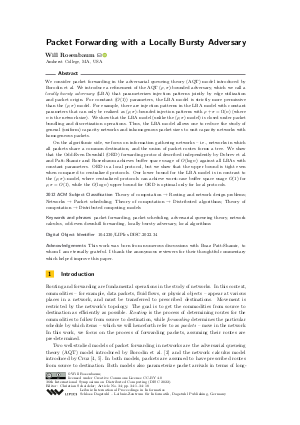@InProceedings{rosenbaum:LIPIcs.DISC.2022.34,
author = {Rosenbaum, Will},
title = {{Packet Forwarding with a Locally Bursty Adversary}},
booktitle = {36th International Symposium on Distributed Computing (DISC 2022)},
pages = {34:1--34:18},
series = {Leibniz International Proceedings in Informatics (LIPIcs)},
ISBN = {978-3-95977-255-6},
ISSN = {1868-8969},
year = {2022},
volume = {246},
editor = {Scheideler, Christian},
publisher = {Schloss Dagstuhl -- Leibniz-Zentrum f{\"u}r Informatik},
address = {Dagstuhl, Germany},
URL = {https://drops.dagstuhl.de/entities/document/10.4230/LIPIcs.DISC.2022.34},
URN = {urn:nbn:de:0030-drops-172254},
doi = {10.4230/LIPIcs.DISC.2022.34},
annote = {Keywords: packet forwarding, packet scheduling, adversarial queueing theory, network calculus, odd-even downhill forwarding, locally bursty adversary, local algorithms}
}

 Creative Commons Attribution 4.0 International license
Creative Commons Attribution 4.0 International license

